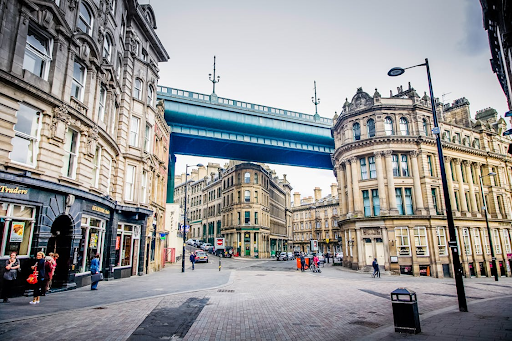Britain’s coastline is more than just a scenic backdrop. For centuries, it has inspired authors to weave the drama of the sea into their stories, from windswept romance to tense mysteries. Each tide brings something new, sometimes calm and glittering, other times wild and unpredictable. It is this sense of constant change that mirrors the thrill of online roulette, where every spin offers the possibility of a surprise. Exploring seaside towns and beaches connected to British literature allows readers to step into the pages of their favourite novels while experiencing the real-life landscapes that shaped them.
Whitby – Gothic Cliffs and Endless Horizons
Whitby, perched on the Yorkshire coast, is perhaps best known in literature for its role in Bram Stoker’s Dracula. The dramatic ruins of Whitby Abbey watch over the town, while the steps leading down to the harbour seem made for a suspenseful scene. Stoker was inspired by the eerie beauty and ever-changing moods of the sea here. Whether the tide is rushing in or retreating quietly, there is a sense that anything might happen – a feeling as gripping as waiting to see where a roulette ball will land.
Brighton – Social Scenes and Seaside Glamour
Brighton has long been a favourite in British fiction, from Jane Austen’s Pride and Prejudice to Graham Greene’s Brighton Rock. Its seaside promenade, lively atmosphere, and elegant architecture have provided countless stories with charm and intrigue. In Austen’s day, Brighton represented fashionable society and a hint of scandal, making it a perfect stage for dramatic twists. Today, the city still hums with energy, much like the buzz of a crowded gaming floor, where conversations, laughter, and anticipation fill the air.
Cornwall – Wild Shores and Timeless Tales
Cornwall’s rugged coastline has inspired authors such as Daphne du Maurier, whose Rebecca and Jamaica Inn are infused with the mystery and danger of the sea. The crashing waves and hidden coves suggest both beauty and risk. This blend of allure and unpredictability is central to Cornwall’s appeal, much as it is to a well-played game. Travellers here can walk along cliff paths, visit fishing villages, or stand at the water’s edge, imagining the storms and shipwrecks that sparked these classic tales.
Lyme Regis – Fossils, Romance, and Reflection
This Dorset town gained literary fame in John Fowles’s The French Lieutenant’s Woman and Jane Austen’s Persuasion. The iconic Cobb harbour wall, often battered by waves, is both a place of quiet reflection and a symbol of resilience. Authors have captured its atmosphere as one of longing, choice, and change – emotions that align with moments of risk and reward in games of chance. The sea here is never the same twice, making it a fitting metaphor for any moment where the outcome is uncertain.
St Ives – Artistic Inspiration and Gentle Shores
St Ives, with its soft sands and vibrant light, has inspired both visual artists and authors, including Virginia Woolf in To the Lighthouse. The shifting colours of the sea and sky are central to the town’s charm. In literature, St Ives often appears as a place of contemplation, where characters find clarity or face personal crossroads. Much like a spin at the roulette table, the possibilities here feel open-ended, with each moment shaped by subtle changes in the surrounding world.
Scarborough – Coastal Energy and Cultural Life
Scarborough blends the charm of a seaside holiday with cultural depth. Authors from Anne Brontë to Winifred Holtby have featured the town in their works, capturing both its gentle beaches and lively events. The dual nature of Scarborough – peaceful yet full of activity – reflects the way literature can offer both comfort and surprise. This balance of relaxation and excitement is not unlike the ebb and flow of a game, where moments of calm are quickly replaced by bursts of action.
Linking Literature and the Sea’s Uncertainty
What makes these coastal settings so enduring in literature is their unpredictability. A calm day can turn stormy in moments, and a familiar scene can feel entirely new with the shift of light or tide. For authors, this creates endless possibilities for storytelling. For visitors, it means every trip is different, with fresh perspectives and discoveries waiting along the shore. This same feeling of possibility is part of what keeps people returning to games like roulette, where no two spins are ever the same.
Planning Your Own Coastal Literary Tour
Exploring Britain’s literary coastline can be as relaxed or as adventurous as you choose. You might start in the south, tracing Austen’s and Woolf’s inspirations, then head north to walk in Stoker’s and Brontë’s footsteps. Many of these towns also host book festivals, readings, or heritage events, adding to the experience. Travelling in different seasons reveals new moods – from the bright, bustling summer beaches to the quiet, reflective winter seascapes.
The Final Word
British literature’s coastal chapters remind us that the sea is more than a backdrop. It is a character in its own right, shaping stories with its moods, rhythms, and unpredictability. Visiting these seaside settings allows readers to connect more deeply with the novels they love, while also experiencing the thrill of uncertainty that has always drawn people to the coast. Like a spin of the roulette wheel, each visit offers something new – and it is that promise of discovery that keeps us coming back to both the shore and the stories it inspires.


